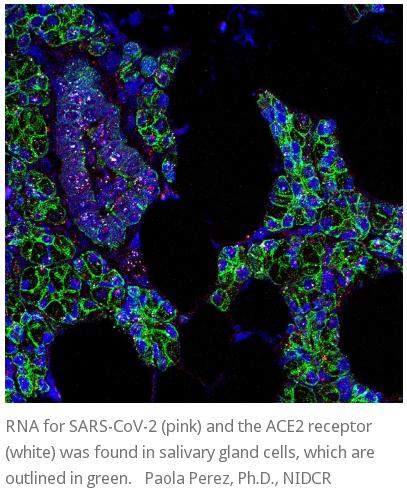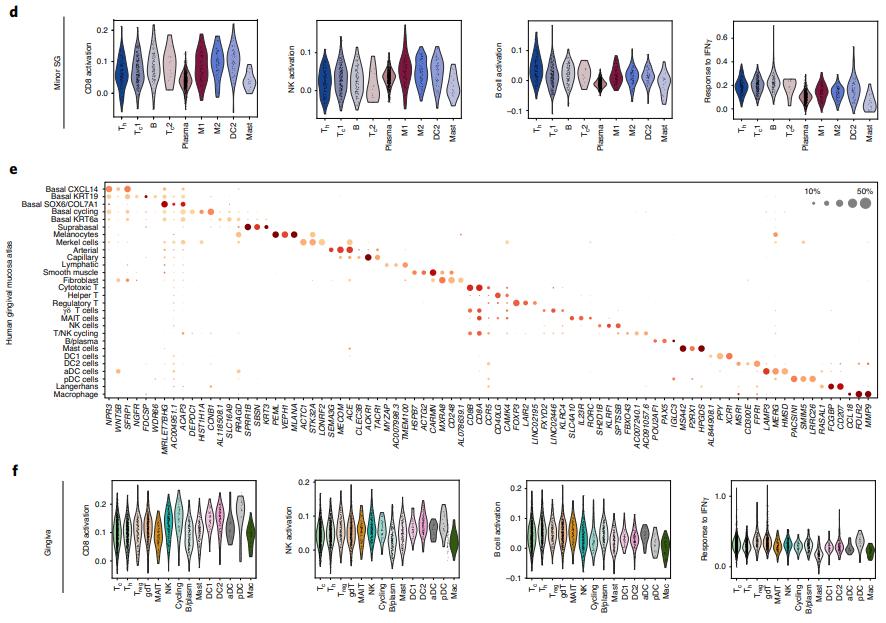博文
科学家发现新冠病毒感染口腔细胞的证据
 精选
精选
||
科学家发现新冠病毒感染口腔细胞的证据
诸平
Fig. 1 | Single-cell atlases of distinct oral tissue niches reveal diverse immune and epithelial cells. a,b, Using unpublished datasets, UMAPs of scRNA-seq data from dissociated (a) minor SGs and gingiva (b) delineate cell population contribution by sample and cell type annotation. We found 22 populations in the SG (7,141 cells) and 28 populations in the gingiva (6,683 cells). c–f, Distinct SG cell subpopulations were defined by a (c) dot plot expression matrix. Gene set (MSigDB) analysis for immune activation pathways (d) does not show clear enrichment, pointing to cells being in a resting/homeostatic state in the SGs. Gingival cell atlases were also defined by a dot plot expression matrix. f, Despite these biopsies coming from minorly inflamed gingival tissues (gingival index scoring an average of 1 out of 3), MSigDB analysis revealed minimal activation of T, natural killer and B cell populations. For gene lists related to a–d, see Supplementary Table 1. IFN, interferon; NK, natural killer; DC, dendritic cell.
据美国国家卫生研究院(NIH)网站2021年3月25日报道,NIH资助的发现指出唾液在SARS-CoV-2传播中的作用。上述由NIDCR博士Paola Perez提供的图片显示,在唾液腺细胞中发现了SARS-CoV-2(粉红色)和ACE2受体(白色)的RNA,其轮廓为绿色。
一个由国际科学家组成的研究团队发现了证据,表明导致COVID-19的病毒SARS-CoV-2感染了口腔细胞。众所周知,上呼吸道和肺是SARS-CoV-2感染的主要部位,但有线索表明该病毒可以感染人体其他部位的细胞,例如消化系统、血管、肾脏细胞,最新研究表明还有口腔细胞。该病毒感染人体多个部位的潜力可能有助于解释COVID-19患者所经历的广泛症状,包括口腔症状,例如味觉减退、口干和口腔起水泡。
此外,研究结果表明,口腔可能在将SARS-CoV-2通过唾液传播到肺部或消化系统中发挥了作用,唾液中含有来自被感染口腔细胞的病毒。更好地了解口腔的作用可以制定出减少病毒在体内和体外传播的策略。该研究小组由美国国立卫生研究院和北卡罗来纳大学教堂山分校(University of North Carolina at Chapel Hill)的研究人员领导。相关研究结果于2021年3月25日在《自然医学》(Nature Medicine)杂志网站发表——Ni Huang, Paola Pérez, Takafumi Kato, Yu Mikami, Kenichi Okuda, Rodney C. Gilmore, Cecilia Domínguez Conde, Billel Gasmi, Sydney Stein, Margaret Beach, Eileen Pelayo, Jose O. Maldonado, Bernard A. Lafont, Shyh-Ing Jang, Nadia Nasir, Ricardo J. Padilla, Valerie A. Murrah, Robert Maile, William Lovell, Shannon M. Wallet, Natalie M. Bowman, Suzanne L. Meinig, Matthew C. Wolfgang, Saibyasachi N. Choudhury, Mark Novotny, Brian D. Aevermann, Richard H. Scheuermann, Gabrielle Cannon, Carlton W. Anderson, Rhianna E. Lee, Julie T. Marchesan, Mandy Bush, Marcelo Freire, Adam J. Kimple, Daniel L. Herr, Joseph Rabin, Alison Grazioli, Sanchita Das, Benjamin N. French, Thomas Pranzatelli, John A. Chiorini, David E. Kleiner, Stefania Pittaluga, Stephen M. Hewitt, Peter D. Burbelo, Daniel Chertow, NIH COVID-19 Autopsy Consortium, HCA Oral and Craniofacial Biological Network, Karen Frank, Janice Lee, Richard C. Boucher, Sarah A. Teichmann, Blake M. Warner, Kevin M. Byrd. SARS-CoV-2 infection of the oral cavity and saliva. Nature Medicine, Published: 25 March 2021. DOI: 10.1038/s41591-021-01296-8. https://doi.org/10.1038/s41591-021-01296-8
NIH下属的国立牙科和颅面研究所(National Institute of Dental and Craniofacial Research简称NIDCR)所长丽纳·索萨(Rena D'Souza)说:“由于NIH对这种流行病采取了全力以赴的反应,美国NIDCR的研究人员能够迅速地运用自己在口腔生物学和医学领域的专业知识,并回答有关COVID-19的关键问题。这种方法的力量在这个科学团队的努力中得到了体现,他们确定了口腔在SARS-CoV-2感染和传播中可能发挥的作用,这一发现增加了对抗这种疾病的关键知识。”
发表在《自然医学》杂志上的研究项目,由NIDCR唾液疾病部门(NIDCR’s Salivary Disorders Unit)主任、临床助理研究员布莱克·沃纳(Blake M. Warner)博士,和当时是北卡罗来纳大学教堂山分校亚当斯牙科学院(Adams School of Dentistry)的助理教授凯文·伯德(Kevin K. Byrd)博士领导。需要说明凯文·伯德现在是美国牙科协会科学研究院(American Dental Association Science and Research Institute)的安东尼·沃尔普(Anthony R. Volpe)研究学者。联合第一作者是英国剑桥惠康·桑格研究所(Wellcome Sanger Institute in Cambridge)的黄妮(Ni Huang)博士和NIDCR的葆拉·佩雷斯(Paola Perez)博士。
研究人员已经知道,患有COVID-19的人的唾液中可能含有高水平的SARS-CoV-2,而且研究表明,唾液检测与诊断COVID-19的深鼻拭子几乎一样可靠。然而,科学家并不完全知道唾液中SARS-CoV-2的来源。在具有呼吸道症状的COVID-19人群中,唾液中的病毒可能部分来自鼻腔引流或肺部咳嗽产生的痰。但是根据布莱克·沃纳的说法,这可能无法解释这种病毒是如何进入那些缺乏呼吸道症状的人的唾液中的。
“根据我们实验室的数据,我们怀疑唾液中至少有一些病毒可能来自口腔本身的感染组织,”布莱克·沃纳说。
为了探索这种可能性,研究人员对健康人的口腔组织进行了调查,以确定易受SARS-CoV-2感染的口腔区域。易受伤害的细胞包含RNA指令,用于制造病毒进入细胞所需的“侵袭蛋白(entry proteins)”。在唾液腺和口腔内衬的组织的某些细胞中发现了两种关键侵袭蛋白的RNA,称为ACE2受体(ACE2 receptor)和TMPRSS2酶(TMPRSS2 enzyme)。在唾液腺和牙龈细胞的一小部分中,ACE2和TMPRSS2的RNA在同一细胞中表达。这表明脆弱性增加,因为认为该病毒需要两种侵袭蛋白才能进入细胞。
布莱克·沃纳说:“进入因子的表达水平类似于已知易受SARS-CoV-2感染的区域中的表达水平,例如上呼吸道鼻道内衬的组织。”
一旦研究人员确认口腔部分部位易受SARS-CoV-2感染,他们就在COVID-19患者的口腔组织样本中寻找感染的证据。在美国国立卫生研究院(NIH)从已死亡的COVID-19患者身上收集的样本中,检测的唾液腺中略多于一半存在SARS-CoV-2 RNA。在一名死者的涎腺组织以及一名急性COVID-19患者的涎腺组织中,科学家们检测到特定的病毒RNA序列,这表明细胞正在积极制造病毒的新拷贝,进一步支持了感染的证据。
一旦研究小组发现了口腔组织感染的证据,他们想知道这些组织是否可能是唾液中的病毒来源。情况似乎是这样的。在轻度或无症状COVID-19患者中,从口腔脱落到唾液的细胞被发现含有SARS-CoV-2 RNA以及用于侵袭蛋白质的RNA。
为了确定唾液中的病毒是否具有传染性,研究人员将8名无症状COVID-19患者的唾液暴露在培养皿中培养的健康细胞中。其中两名志愿者的唾液导致健康细胞感染,这增加了即使没有症状的人也可能通过唾液将传染性SARS-CoV-2传染给他人的可能性。
最后,为了探索口腔症状与唾液中病毒之间的关系,研究小组从35名患有轻度或无症状COVID-19的NIH志愿者的另一组中收集了唾液。在出现症状的27个人中,唾液中带有病毒的人更有可能报告味觉和嗅觉丧失,表明口腔感染可能是COVID-19口腔症状的基础。
研究人员说,总的来说,这项研究发现表明,通过感染的口腔细胞,口腔在SARS-CoV-2感染中的作用比以前想象的要大。
凯文·伯德说:“吞下被感染的唾液或吸入其中的微小颗粒时,我们认为它可能将SARS-CoV-2进一步传播到我们的喉咙、肺部甚至肠道。”
需要更多的研究来确认更多人群的发现,并确定口腔中SARS-CoV-2感染和体内外传播的确切性质。布莱克·沃纳说:“通过揭示口腔在SARS-CoV-2感染中潜在的未被充分认识的作用,我们的研究可以开辟新的研究途径,从而使人们更好地了解感染和疾病的进程。这些信息还可以为抗击病毒和减轻COVID-19的口腔症状提供信息。”
这项研究得到了NIDCR院内研究部(NIDCR Division of Intramural Research)的支持。美国国家糖尿病、消化与肾脏病研究所(National Institute of Diabetes and Digestive and Kidney Disease简称NIDDK)资助(DK034987)和NIDDK内部计划的支持,美国国家癌症研究所(National Cancer Institute),NIH临床中心(NIH Clinical Center)以及美国过敏和传染病研究所(National Institute of Allergy and Infectious Diseases)也提供了支持。另外还有美国牙周病学会/ 日星基金会(American Academy of Periodontology/Sunstar Foundation)、美国肺脏协会(American Lung Association)和囊性纤维化病基金会(Cystic Fibrosis Foundation)也提供了额外的支持。上述介绍仅供参考,更多信息敬请注意浏览原文或者相关报道。
Despite signs of infection—including taste loss, dry mouth and mucosal lesions such as ulcerations, enanthema and macules—the involvement of the oral cavity in coronavirus disease 2019 (COVID-19) is poorly understood. To address this, we generated and analyzed two single-cell RNA sequencing datasets of the human minor salivary glands and gingiva (9 samples, 13,824 cells), identifying 50 cell clusters. Using integrated cell normalization and annotation, we classified 34 unique cell subpopulations between glands and gingiva. Severe acute respiratory syndrome coronavirus 2 (SARS-CoV-2) viral entry factors such as ACE2 and TMPRSS members were broadly enriched in epithelial cells of the glands and oral mucosae. Using orthogonal RNA and protein expression assessments, we confirmed SARS-CoV-2 infection in the glands and mucosae. Saliva from SARS-CoV-2-infected individuals harbored epithelial cells exhibiting ACE2 and TMPRSS expression and sustained SARS-CoV-2 infection. Acellular and cellular salivary fractions from asymptomatic individuals were found to transmit SARS-CoV-2 ex vivo. Matched nasopharyngeal and saliva samples displayed distinct viral shedding dynamics, and salivary viral burden correlated with COVID-19 symptoms, including taste loss. Upon recovery, this asymptomatic cohort exhibited sustained salivary IgG antibodies against SARS-CoV-2. Collectively, these data show that the oral cavity is an important site for SARS-CoV-2 infection and implicate saliva as a potential route of SARS-CoV-2 transmission.
https://wap.sciencenet.cn/blog-212210-1278902.html
上一篇:新方法可以为运动障碍者带来“治愈之光”
下一篇:科学家发现了阻碍使量子点更亮的过程


